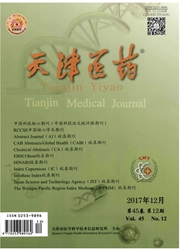

 中文摘要:
中文摘要:
目的:测定不同程度间歇低氧(IH)处理的3T3-L1脂肪细胞中炎性细胞因子和脂肪因子水平的变化。方法建立阻塞性睡眠呼吸暂停(OSA)模式间歇低氧/再氧合(IH/ROX)细胞模型,将分化成熟的3T3-L1脂肪细胞分为5组,即3个不同程度IH组(5%O2,7.5%O2,10%O2,编号为IH-1,IH-2,IH-3)、持续低氧(10%O2,CH)组和正常氧对照(21%O2,IN)组。采用ELISA法测定脂肪细胞上清液中肿瘤坏死因子(TNF)-α、白细胞介素(IL)-6、瘦素和脂联素的水平,Western blot测定脂肪细胞中低氧诱导因子(HIF)-1α、葡萄糖转运蛋白(Glut)-1水平,Real-time-PCR测定脂肪细胞中HIF-1α、Glut-1、TNF-α、IL-6、瘦素、脂联素的mRNA表达水平。结果 IH组和CH组TNF-α、IL-6和瘦素蛋白及其mRNA水平均高于IN组,IH-1组TNF-α、IL-6和瘦素蛋白及瘦素mRNA水平高于IH-2、IH-3组(均P<0.05);IH组和CH组脂联素蛋白及其mRNA水平均低于IN组,IH-1组低于IH-2、IH-3组(均P<0.05)。结论OSA模式IH与脂肪细胞炎性细胞因子和脂肪因子的表达和释放有关,IH可能是脂肪细胞炎症反应的基础,参与OSA患者胰岛素抵抗的发生。
 英文摘要:
英文摘要:
Objective To study the effect of different degrees of intermittent hypoxia (IH) on inflammatory cytokines and adipokines in 3T3-L1 adipocytes. Methods An intermittent hypoxia/reoxygenation (IH/ROX) from obstructive sleep apnea (OSA) adipocyte model was established. 3T3-L1 adipocytes were divided into five groups, three IH groups (5% O2, 7.5%O2 and 10%O2, referred to as IH-1, IH-2 and IH-3), sustained hypoxia group (10%O2, CH) and the normal oxygen control group (21%O2, IN). ELISA method was used to detect values of tumor necrosis factor alpha (TNF-α), interleukin-6 (IL-6), leptin and adiponectin in cell supernatant. Western blot analysis was used to detect levels of hypoxia-inducible fac-tor-1α(HIF-1α) and glucose transporter-1 (Glut-1). RT-PCR assay was used to analyze HIF-1α, Glut-1, TNF-α, IL-6, leptin and adiponectin mRNA expression levels in adipocytes. Results The expression levels of TNF-α, IL-6 and leptin were significantly higher in IH and CH groups than those of IN group (P〈0.05). The expression levels of TNF-α, IL-6 and leptin protein and leptin mRNA were significantly higher in IH-1 group than those of IH-2 and IH-3 groups (P〈0.05). The adiponectin and its mRNA levels were significantly lower in IH and CH groups than those of IN group (P〈0.05). The adipo-nectin level was significantly lower in IH-1 group than that of IH-2 and IH-3 groups (P〈0.05). Conclusion These results demonstrate that IH is related to the extensive changes in the expression and release of inflammation-related adipokines in cultured adipocytes. IH from OSA may underlie the development of the inflammatory response in adipocytes, which is in-volved in insulin resistance in patients with OSA.
 同期刊论文项目
同期刊论文项目
 同项目期刊论文
同项目期刊论文
 Intermittent hypoxia from obstructive sleep apnea may cause neuronal impairment and dysfunction in c
Intermittent hypoxia from obstructive sleep apnea may cause neuronal impairment and dysfunction in c Lymphocytes from intermittent hypoxia-exposed rats increase the apoptotic signals in endothelial cel
Lymphocytes from intermittent hypoxia-exposed rats increase the apoptotic signals in endothelial cel 期刊信息
期刊信息
